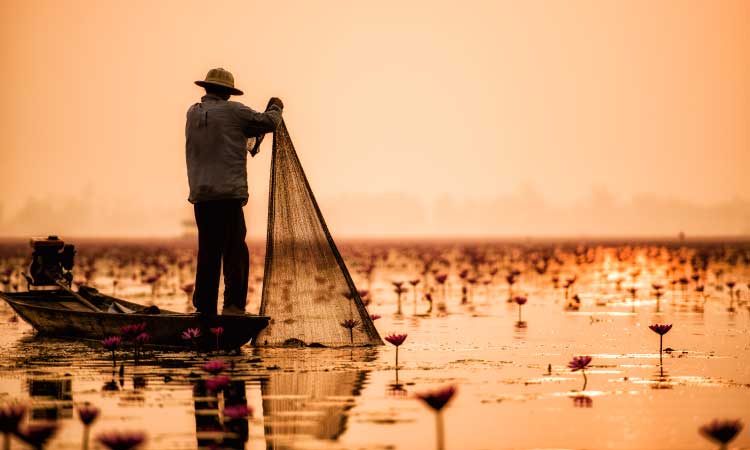Everything You Need to Know About Biofloc Technology in Fish Farming and its Profitability

Fishery is one of the biggest source of food in this world. Fishery is a word described for raising and harvesting fish for consumption as food. There is a big channel of resources and people involved in raising and harvesting fish in order to sustain the food required in the world. Fishing is therefore one of the biggest source of employment in the world. As of 2016, fish production was at all-time high which was calculated to be 171 million tons. Out of the number, 88% of the production was consumed directly by the humans.
Since the consumption of fish has reached to record high it is not possible to meet the demand using the traditional methods of fishing. With the changing times fishery industry has adopted more innovating and efficient methods of raising and harvesting fish in order to sustain the requirements. One of such methods is the biofloc technology which is method evolved to deal with waste water management, maintain bio-chemical cycles and to maintain the nutrition level of the aquatic life.
The method of seen immense growth within a short span and at present is used extensively to ensure high growth of aquatic life and the fishing industry. It is without doubt that there has been multifold rise in the demand of aquatic food and the old method of food production was not sufficient hence the fishery industry has adopted this very successful method known as biofloc technology to deal with the production of aquatic food in order to meet the demands.

What is Biofloc Technology?
Biofloc technology basically aims at converting the toxic waste material generated within the aquatic water into protein rich food for the aquatic life. Secondly, biofloc technology aims at maintain a healthy atmosphere in the water by regulating the carbon-nitrogen cycle within the water and ensures that the bio-chemical speeds up which makes the water quality optimum for the successful growth of aquatic life. Lastly, this method also accelerates the growth of bacteria, fungus and single cell organisms which initiated the bio-chemical cycle.
High stocking density and the rearing of the aquatic lives requires fine treatment of waste water which improves the living standard of the aquatic living beings which indeed ensures a healthy and prosperous growth of aquatic animals such as the fish. The nitrogenous waste can be turned into protein rich feed for the aquatic animals which amounts 60% of the production cost.
For the whole process maintaining of C: N ration is important which is done by enriching carbohydrate sources such as the molasses. The water quality is improved by increasing the production of bacteria, fungus and single cell organisms. These organisms break downs the nitrogen and carbohydrates similar to as a bio reactor and turns them into feed for the aquatic animals. Using the same method quality of water is also improved.
The Problem in the Fishing Industry:
With the rising population and demand for food fishing sector got into huge stress. The demand of fishes went up while the production still followed the old methods of fishing which looked redundant in front of the demand. The old method was simple like creating a pond or similar water body and then raising fish while providing all the required supplements. Since this method was natural hence the growth of fishes took place at normal rate thus unable to meet the demand.
The problem worried the members of industry and that is when new methods for fishing were adopted in order to meet the demand. While raising the fish the water quality worsened which also impacted the production. One common reason was that only limited number of fishes could be raised in a given water body. On increasing the density of fishes in the water the oxygen level depleted and the quality of water also worsened thus hampering the production.
Two factors namely the fall in oxygen level and the water waste created by the aquatic animals were matter of concern. This is still manageable in rivers and sea but a stagnant water body had to face huge problems. Manual cleaning of the pond was thus used and increasing the oxygen level was adopted to meet the oxygen level but managing the water waste and cleaning turn out to be expensive. Biofloc method thus was invented and implemented to solve both the problems.
Biofloc Technology a Preferable Choice:
Many experiments were conducted in order to evaluate whether the biofloc technology was good enough to be implemented. Several parameters were evolved and tests were conducted to measure the water quality and oxygen level of the water. It was found that biofloc method was effective in maintaining the required oxygen level, mineral quality, alkaline nature, PH level, etc.
It was found that using biofloc technology fishes reached their required average size within 30 days while without biofloc method it took 45 days for fishes to reach their average size. Other researches were also conducted in order to determine the production cost using biofloc technology and clear water system. It was found that the production cost using biofloc technology was 20-30% higher than that of traditional fresh water method.
But the total profit generated using biofloc technology was 23% higher than the profit generated using fresh water method. Thus the net profit generated was also higher than the fresh water method. It was proved that biofloc technology not only increases the production, reduces the time required but also increases the net profit. A very influencing reason to adopt the biofloc technology into usage.
Benefits of Biofloc Technology Culture System:
With the results allover it is evident that biofloc technology is better in use and has very less bad impact on the fishery sector in comparison to any human made method. Biofloc technology has not only risen the profits but also has served better for the aquatic life. Here are some of the benefits of biofloc technology.
- Biofloc technology is an eco-friendly method of rearing fish. It is least harmful to the environment, the aquatic life and the consumers.
- It reduced environmental impact as it uses the water waste into useful protein rich feed for the aquatic life thus reducing the generation of waste and its management cost
- It also improves the land and water use efficiency as it increases the density of fishes in the water body thus accommodating more fishes in the limited water space. Since there will be less space required to accommodate more fishes the use of land will also reduce thus further reducing the cost of production.
- Limited or zero water exchange reduced the consumption of water which is also very tough to manage at water scarce places.
- It increases the productivity of fishery products as it ensures higher survival rate, improves growth performance and feed conversion in the aquatic world.
- It also ensure higher biosecurity
- It helps in reduction of water pollution which is a big problem in the aquatic life. It also reduces the risk of rising pathogens and their spread
- Most importantly it is cost effective and doesn’t requires higher production cost but a minimal given it also increases the net profit.
- It reduces the cost required to feed the aquatic animals by converting the wastes into protein rich feed.
Production of fishery products has risen using this method as it is efficient on all the aspects of fish rearing. The rise in net profits is an example how using this method is beneficial to the fishing industry. It has also proved successful on the environmental aspect as it has reduced the generation of water waste by efficiently converting the waste into protein rich feed for the fishes. Lastly, it has also increased the water quality standard of the water bodies that are used to rear fishes. Overall, biofloc technology has some very good advantages over any other methods of rearing fish.
Disadvantages of using Biofloc Technology:
There are also some disadvantages of using this method. They are:
- Increases the energy requirement for aeration and mixing.
- Using this method it has been observed that it reduced the response time as water respiration rates got elevated
- There is startup period required which is not the case in fresh water methods
- Alkalinity supplementation is required unlike the fresh water method.
- Biofloc method increases the accumulation of nitrate thus increases the pollution potential
- For sunlight exposed systems it can be harmful as it may result in inconsistent and seasonal performance impacting the production
- Since the method is a bit artificial it requires lots of caring and managing which is not the case in fresh water method. Though the production maybe high but the quality of product generated may not be satisfying.
Biofloc technology is at the forefront of fish production. Many people who have invested in this method have made huge revenue from it as it has improved production and profit. It has also reduced the time required in raising the fish which means that within a fixed time fishes can be raised many a times. Thus, biofloc technology is profitable in raising and rearing fish.
FAQS
Fish farming is the practice of raising fish for commercial production, commonly in controlled environments such as tanks. It is an important aquaculture practice that has been used for centuries around the world.
The most commonly farmed fish include salmon, catfish, carp, tilapia, and trout.
Fish farming offers economic benefits to communities such as creating jobs, generating income, and providing food security. It also helps in conservation of wild fish stocks.
Yes, it can be highly profitable depending on chosen species, management practices and access to markets.
Principles of sustainable fish farming should be followed to ensure healthy aquatic ecosystems and efficient profits. These include making sure food and oxygen levels are maintained and water is recycled to preserve natural resources.
Fish farming can be susceptible to disease and parasites, and can suffer from overcrowding and pollution. Proper water quality and management are essential for success in fish farming.
Basic equipment includes tanks, nets, feeders, filtration systems and aeration devices. Additionally, specific equipment may be needed depending on the species (e.g. breeding, spawning and incubators).
Start-up costs of fish farming depend on the species, size of the facility, and other factors. However, costs may range from a few thousands to hundreds of thousands of dollars.
Methods to increase profit include increasing production efficiency, improving water quality and management, mechanization, and finding ways to reduce costs and reduce waste.
Integrated Aquaculture is a method of farming both fish and plants together in a single system. This can help to reduce costs, improve water quality, and increase yields by utilizing the nutrients within the system and supplying food to the fish.





